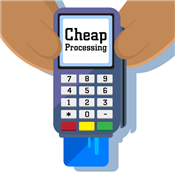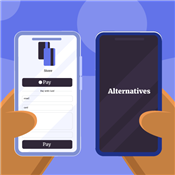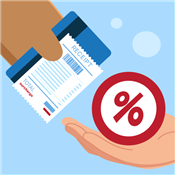No Refund Policy
Thinking about a "no returns" policy for your business? Find out how to write a fair, easy-to-understand no refund policy, and how to enforce it.
 |
In 2020, businesses lost a total of $428 billion of sales revenue to returns.[1]
When returns damage your bottom line, should your business adopt a no returns/no refund policy?
There are certain situations where it makes sense to not offer refunds. And it is within your right to do so. But there are things to be careful about.
In this guide, learn everything you need to know about writing a "no refund" policy and enforcing it.
Is It Legal to Have a No Refund Policy?
In the United States, there is no federal or state law that you must offer refunds. Merchants can set their own policies. But several states do have laws about displaying the refund policy.
In most cases, you need to conspicuously display your no refund policy so the customer sees it before making the purchase. If you don't have it clearly displayed, then customers are entitled to returns within a reasonable number of days (usually 30 days).
Even if your state doesn't have a specific law about it, it's still best business practice to be clear about your policy. Otherwise, you'll run into trouble with angry and confused customers.
Pros of a No Refund Policy
Before we get into the specifics of writing a no refund policy, let's first consider the pros and cons. Is it the right move for your business?
Here are some benefits to not allowing returns:
Keep more revenue
This one is obvious. When customers can't make returns, you get to keep the revenue from sales you make.
Customer safety
Lots of retailers don't allow refunds on intimates and cosmetics for health and safety concerns. This protects customers from buying something that's potentially been used.
Less chargebacks
Sometimes customers go through their bank to get a refund, resulting in a chargeback for the merchant. If you clearly have a no refund policy stated, it's a stronger case for reversing the chargeback (provided that you delivered the product as described).
Cons of No Refund Policy
However, there are also just as many cons. Here's how a no refund policy can hurt you.
Turn away customers
91% of people say that a store's return policy is important when making a purchase decision. [2] People like knowing they have the option to return a product if they don't like it.
If you don't offer refunds, customers might go to a competitor shop instead. This is especially true for online stores, where you can't see the item first before purchasing.
Less trust in your store
People associate a money-back guarantee with trust that a business stands behind their products. A "no refund" policy could look suspicious.
Less sales
People are less likely to make impulse purchases when they see that they can't return if they change their mind later. In a study done by University of Texas-Dallas, it was found that a lenient return policy also led to more purchases.
How a No Refund Policy Works
It is entirely at the merchant's discretion whether to offer refunds. If you do decide to adopt a no return policy, the important thing is that it's displayed correctly. Otherwise, it's not valid.
Your no refund policy must be conspicuously displayed and communicated to customers before they complete the purchase. Only having it on the receipt is not enough, since customers don't see it beforehand.
Some places you want to post the no-refund policy are:
In store:
- On a sign displayed at the checkout counter
- On the tag of the product
- Printed on the receipt
- Verbally communicated to customer before checkout
Online:
- On your website terms and conditions
- On the product page near the "buy" button
- Reminder before the final checkout
- In the purchase confirmation email
Another important note is that no refund policies can only apply to "change of mind" purchases. For defective or incorrect products, the merchant must make it right for customers (which we'll talk about later).
Now that we've gone over the basics, it's time to get into the details of what exactly you need in a no refund policy. Read on.
How to Write and Enforce a No Refund Policy
If you've decided that a no refund policy is the way you want to go, the next step is to write your policy. While a refund policy is not required by law, it's still important to have a clear policy to protect your business.
We'll go through step-by-step (with examples) how to write and enforce your no refund policy. Here are the things you want to include.
1. Specify What Is Not Returnable
Are all your products final sale only? Or do you want to apply the no-return policy to specific items only?
Here are some common items that are appropriate for no-refund policies:
- Clearance items
- Digital products
- Undergarments
- Cosmetics/Toiletries
- Bedding
- Food products
- Flowers and plants
- Custom orders
- Single use products
- Merchandise marked "as is"
- Subscription boxes
These types of items have more risk that someone opened and used it, making it hard or unhygienic to resale. For digital products, it's common to say no returns, since you own it once you download it.
For example, Boxlunch, a novelty accessories store, offers 30-day returns, with the following exceptions (shortened list from original). They clearly list each item category and its special policy.
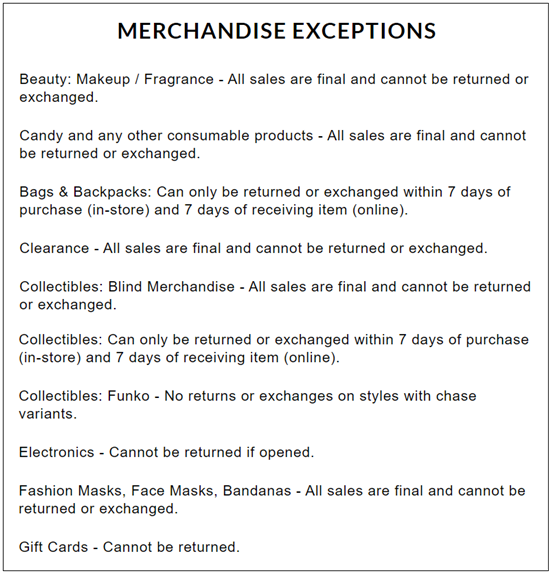 |
And here is the return policy for FabFitFun, a lifestyle subscription box service. It plainly says all sales are final. It's common for subscription services to say "no refund" since customers are on a billing schedule and can cancel the subscription before the next billing.
 |
2. Clarify the Type of No Refund Policy
There are a few variations of no refund policies. You may want to use different types for different items.
- All Sales Final
This means that once the sale is completed, there will be no returns or exchanges allowed of any kind. This is usually applied to the items listed above. If you want to mark certain items as final sale, make sure it's displayed on a sign, tags, or the product page. - Exchange Only
This allows the customer to exchange the product for something else from your store. This at least lets you keep your revenue from the sale. - In-store Credit
Instead of giving them cash back, offer an in-store credit for the amount of the return. This gives customers the chance to make another purchase from your store at a later date.But note that with exchange and in-store credit only policies, the problem could be that if the customer didn't have a good experience in the first place, they may not be happy with these options.
Here's an example from Kira Hawaii, a small local Hawaiian boutique. It states that all jewelry is made to order and thus final sale. For clothing, only exchanges or store credit will be given within 14 days (with certain items being final sale).
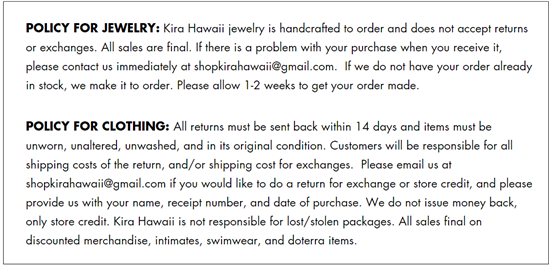 |
Another option is charging a restocking fee. The customer won't get back the full purchase price, so it's kind of like a "partial refund." The restocking fee is meant to cover processing and handling costs to return the product to resalable condition.
Here is an example from The Nail Superstore, which charges a 10% restocking fee. We like that they clearly list the different situations and whether the restocking fee applies. This leaves no room for question.
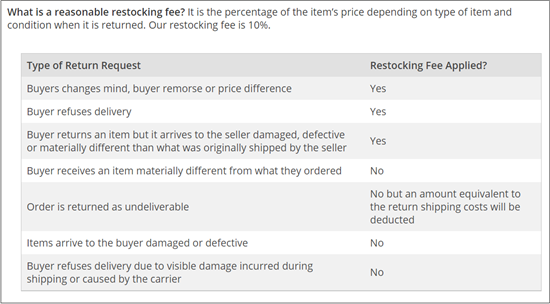 |
3. Time Limitations and Conditions
If there are items you will allow for returns or exchanges, what are the time limitations?
Be sure to also state any conditions for returns, such as that the item must be in original condition with proof of purchase (receipt, order slip, etc.).
For example, it could look something like this:
- Returns within 14 days of purchase are eligible for a full refund, with a receipt and in original packaging with tags attached or unopened.
- Returns from 14 days to 30 days of purchase can be exchanged or will receive in-store credit.
- We will not accept any returns or exchanges after 30 days.
4. Reason for No Refunds
Phrase your return policy in a way to show how it's a benefit to customers. For example, you can say something like:
"To ensure proper hygiene, undergarments, intimates, and swimwear are final sale."
This also gives trust to customers that when they purchase these kinds of items, they are getting something brand-new and clean.
Here is an example of Asos's return policy. It stresses that certain items can't be returned if protective seals have been broken due to concerns for customers' safety. In addition, they inspect the quality of returned items to see if it's eligible for a refund.
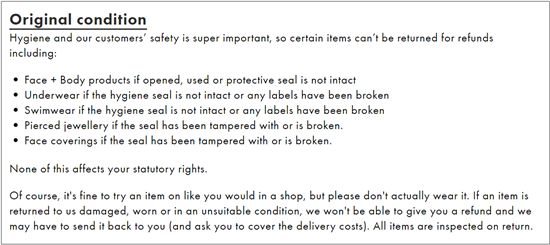 |
- Termly Generator
- Termsfeed Generator
- FreePrivacyPolicy Generator (eCommerce business)
5. Policy for Defective Goods
While it's entirely within your right to prohibit refunds for "changing your mind," there are laws on refunds for these situations:
- Defective products
- Products damaged during transit
- Incorrect item received
- Item not as described
In these cases, it is the seller's responsibility to make it right with the customer.
In your policy, have a separate section for "defective products" so customers can find it easily. State how you will handle the issue, whether it's a cash refund, repair, or replacement.
For example, this is Overstock's policy for defective products:
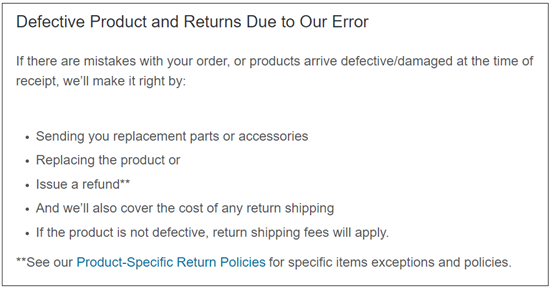 |
Furthermore, they have specific policies for certain items. For large appliances, they first refer you to the manufacturer's warranty to repair the item (below).
 |
Wolverine, the boot brand, even outlines what exactly is considered defective - and more importantly, what's not.
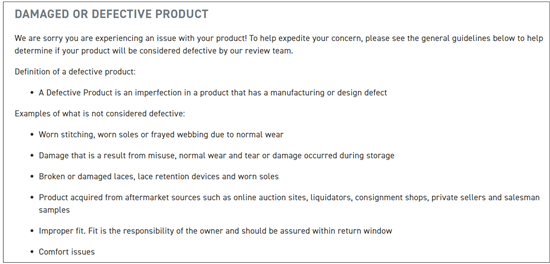 |
6. Other Exceptions to the Policy
Another exception you can make is for gift receipts. If someone got a gift they didn't like (or don't need), they shouldn't have to be stuck with it.
Usually, store credit is given for the amount of the return. This way, you don't lose out on the sale. And the customer can pick something else that they (hopefully) like better.
Here's Barnes and Noble's return policy for gift receipts.
 |
Bottom Line
It's important to weigh the pros and cons when making this important decision for your business. A no refund policy can help your bottom line, but it can also turn away customers to your competitors.
If you do decide that a "no refund" policy is the best way to go, the most important is that it's clearly displayed. That gives the customer a chance to rethink the purchase. You'll also have less risk of a chargeback later.
And lastly, remember that no refunds can only apply to "change of mind" purchases. If a product is faulty, then you must offer a way to resolve the issue.
References
- ^ National Retail Federation, $428 Billion in Merchandise Returned in 2020, Retrieved 6/23/2021
- ^ NY Times, The Importance of a Good Return Policy, Retrieved 6/22/21
Anna G is a contributing writer at CreditDonkey, a credit card processing comparison and reviews website. Write to Anna G at feedback@creditdonkey.com. Follow us on Twitter and Facebook for our latest posts.
Not sure what is right for your business?
|
|
|
Answer a few short questions in our credit card processing quiz to receive tailored recommendations to help you keep more profits.
|
|
| ||||||
|
|
|







